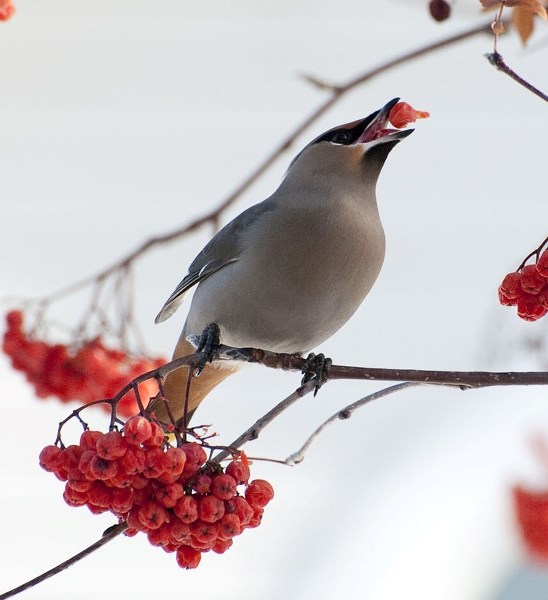It was a sunny winter's day some years ago when a feathered whirlwind whipped through my yard. I was roused from my reading reverie by a rush of wings – as if a storm surge had dashed itself against the window.
It was a sunny winter's day some years ago when a feathered whirlwind whipped through my yard.
I was roused from my reading reverie by a rush of wings – as if a storm surge had dashed itself against the window.
I looked out to see the mountain ash tree outside ablaze with bohemian waxwings, each gobbling berries with gusto. The birds blasted off without warning, only to return seconds later, like some sort of indecisive, ravenous tornado.
I managed to snap exactly one photo of the birds before they scattered for good, the swarm zigzagging through the air in search of its next meal. The tree, once drooping with crimson berries, was now practically bare, and the driveway was a mess of scattered fruit.
Waxwings are as whimsical as the wind – furious cyclones of consumption one moment, gentle breezes gliding on sunlit wings the next. Their song – a simple trill – has always reminded me of falling stars.
Bohemian waxwings usually arrive in St. Albert en masse around this time of year, says local birder Alan Hingston. They're often the most common birds spotted during the Christmas Bird Count, with 2,025 showing up last December.
Bohemians are also featured in the logo for Edmonton's Wildbird General Store, says store co-owner Lu Carbyn. "It's such a dominant bird in Edmonton in the wintertime," he says, and is known for forming huge flocks.
There are three waxwing species in the world, says Royal Alberta Museum ornithologist Jocelyn Hudon, two of which are found in Alberta.
The bohemian (so named due to its constant, gypsy-like roaming) is a grey bird known for its crest, black facemask and yellow-tipped tail. They also have a rusty red underside to their tails and orange and yellow highlights on their wings.
Those orange highlights look like blobs of wax, Hudon explains, which is why these birds are called waxwings. These blobs are made of the same stuff as the feather, not wax, and can't be removed. Waxwings may use these blobs to judge the age of their mates, he says, as mates tend to have similar blob counts and older birds have more blobs.
Bohemians can be confused with cedar waxwings, Hudon notes. Check their bellies to tell which is which. Grey? Bohemian. Yellow? Cedar.
Bohemians are very gregarious, Hudon says, and often travel in swarms of 5,000 or more for protection. They're not very territorial, and don't have a true "this is my turf" song – all they have is a simple trill.
"They are fairly sheepish," he continues, and can be easily startled. They often have twisty, erratic flight patterns as they move between trees, which could be due to the challenge of getting hundreds of birds to move in the same direction.
It can also be because they're drunk. Bohemians live almost exclusively on fruit, Hudon notes, much of which ferments in the winter as it rots. Birds on a berry bender may end up wobbling on the ground or smacking into windows.
Cities are usually packed with fruit trees, Hudon says, so bohemians often move into them during the winter, roaming from tree to tree and laying waste like a frugivorous Mongol horde. "They are fruit-eating machines," he says, and can easily eat a hundred berries a day.
Their numbers in any one place vary wildly due to their erratic migrations, he continues, which can take them as far east as Quebec. Bohemian waxwing numbers have ranged from 76 to 9,010 in the St. Albert Christmas Bird Count.
Bohemians all but vanish from Edmonton during the summer, Carbyn notes. That's when the birds have split into smaller flocks to nest in the boreal forest up north, laying clutches of four to six pale blue eggs at a time.
I always love it when the waxwings blow back into town, bringing a life and frantic energy back to what is otherwise a cold and still winter's day.
Sure, they make a mess of my driveway, but I can live with that. "If you want to have fruit trees," Hudon says, "you can expect waxwings to come with them."
Bohemian waxwing
Name:
Bombycilla garrulus.
<br />Appearance:
Medium-sized songbird with brownish-grey body, crest and mask on head, yellow tail tip, reddish undertail, and orange wax-like markings on wings.
<br />Commonly seen:
Gobbling berries by the hundreds in huge swarms.
<br />Occasionally confused with:
Cedar waxwing, which has a yellow belly.
<br />Fun fact:
A group of waxwings is an "earful" or a "museum."
Like wildlife? So do we! Every second Wednesday the Gazette profiles a reasonably common wild creature in the St. Albert region. Birds, beasts, bugs, fish … so long as it's alive and kicking, we'll feature it. <br /><br />Got a creature you'd like to see profiled? Send your suggestions to [email protected].




